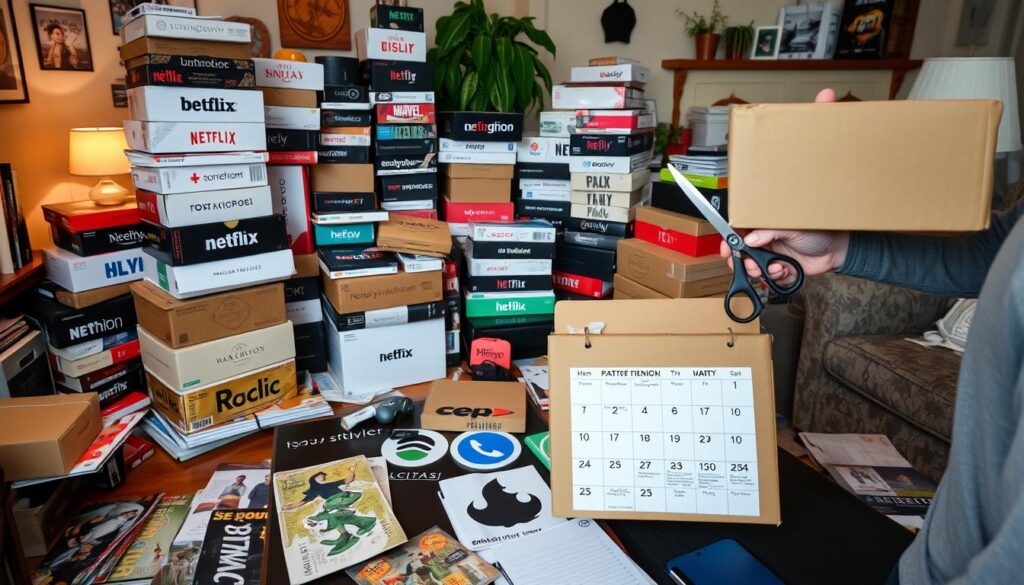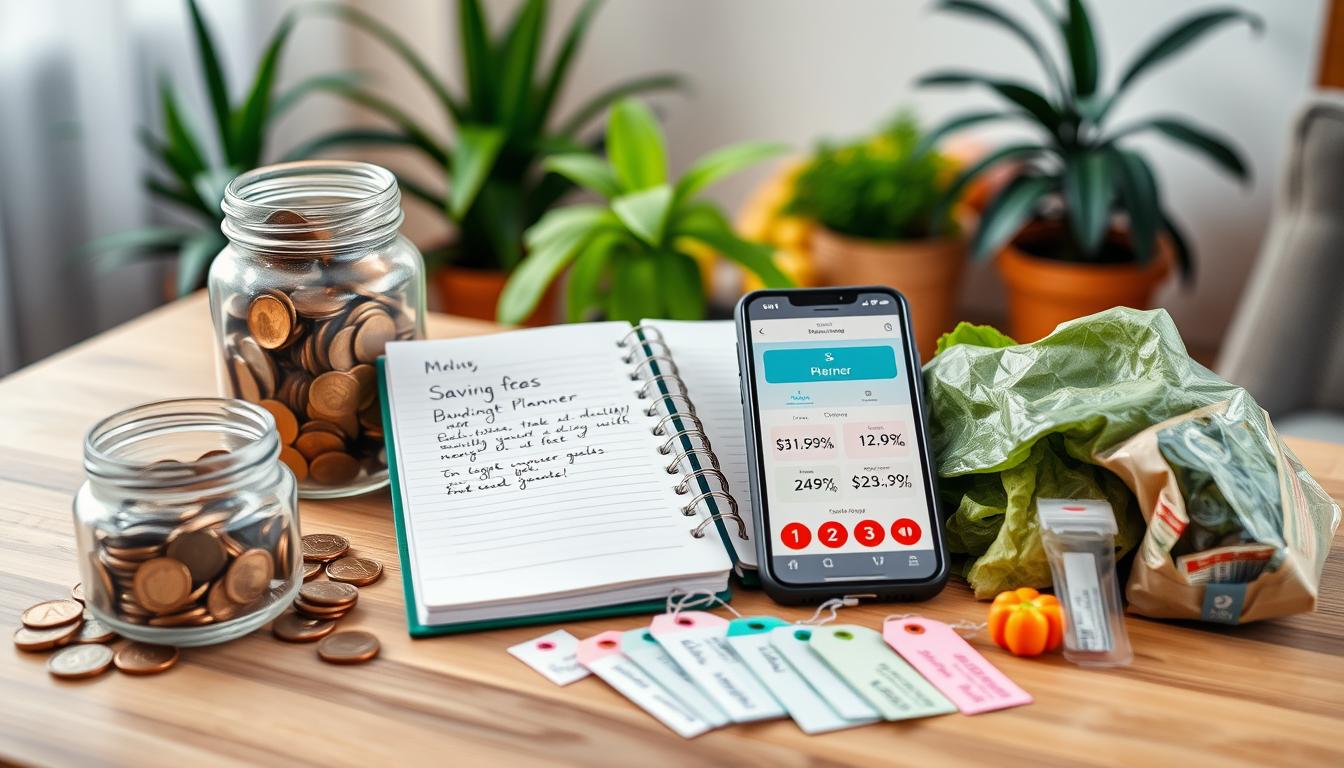Did you know a typical American family could save up to $6,000 each year? This is by following easy money-saving tips and cutting costs. Simple changes to how you manage money can make a big difference1. For instance, picking store brands or cooking at home instead of eating out adds up.
Heather LeMond saved a lot on groceries by planning her shopping. She reduced her weekly food expenses significantly2. This article will share tips and tricks for saving money easily. Learn to live more frugally without giving up your lifestyle. We’ll show you how to make saving money a natural part of your day.
Key Takeaways
- Implementing budgeting tricks can lead to significant savings.
- Simple changes, like shopping smartly, can help reduce expenses dramatically.
- Small habits in frugal living can lead to larger savings.
- Utilizing free shipping services can cut costs on necessary purchases.
- Meal prepping can reduce food waste and save you money.
Understanding the Importance of Saving Money
Saving money is crucial in our fast-moving world. It greatly helps with your financial security. Having savings means you’re ready for unexpected costs.
About 69% of Americans have under $1,000 in savings3. This shows why it’s key to save regularly. Saving helps achieve big dreams like owning a home, studying more, or a relaxed retirement.
Yet, some people don’t see the need to save. The average American family has only $5,000 saved3. Experts advise saving 20% of your income monthly, depending on your situation.
The financial world changes all the time. Using Zero-Based Budgeting (ZBB), every expense must be justified4. This approach cuts out needless spending. It makes your financial future more secure.
Common Mistakes That Drain Your Savings
Many folks make financial mistakes that eat away at their savings. One key problem is spending too much on things we don’t need. This can lead to bigger bills than expected. It’s important to know the difference between what you need and what you want to avoid this.
Not keeping a close eye on your budget can also hurt your savings. You might not notice the small fees in your bills. But together, they can really add up. These hidden costs can make it tough to keep your savings healthy.
It’s smart to check your spending often. Knowing where your money goes can help avoid losing it on surprises. Be careful with each money choice you make. Think about how it might affect your savings in the long run.

To protect your savings, dodge these usual traps. Spot and cut out those extra costs that slow down your saving. Taking charge of your money is key to a secure future5.
The Hidden Tricks to Saving Thousands Every Year—Revealed!
Today, knowing how to cut costs is more important than ever. Two smart ways to do this include no-spend challenges and living simply. These methods do more than save money. They also teach us about our spending patterns.
Embracing No-Spend Challenges to Curb Expenses
A no-spend challenge is a great way to see what you don’t really need to buy. Many people are surprised by how much they can save. They learn to live without buying things just for the sake of it. For instance, some savvy moms use candles instead of lights and wash clothes in cold water. They even reuse water to lower their bills6.
Tips also include smarter use of utilities. Like unplugging devices when you’re not using them6. These small changes add up to big savings.
The Benefits of a Minimalist Lifestyle
Choosing a minimalist lifestyle means valuing experiences more than stuff. This choice leads to better financial health and less clutter. People who live this way often spend less money over time. Making your own cleaning supplies and opting for simple meals are examples of this. These choices can greatly reduce your expenses.
In Australia, people live more minimally by doing things like switching to cheaper utility providers. They also shop at stores with lower prices7. When you focus on what you truly need, you make smarter money choices. This helps your budget and improves your life too.

Insurance Savings: Comparison Shopping Essentials
Getting the most out of your insurance starts with comparison shopping. By looking at offers from different companies, you can cut costs. Insurance prices vary a lot between companies. This means huge savings, sometimes reaching into the hundreds or thousands each year8. Websites that compare for you make this process simple and quick. They give you a lot of options to choose from8.
The Power of Bundling Policies for Discounts
When you bundle your insurance policies, the savings can be big. Many insurers offer discounts for bundling, which lowers your overall costs89. You might get extra savings if you have a clean driving record or strong credit score. Looking into all the discounts can really pay off.
Choosing the Right Insurance Company
There’s more to picking an insurer than just the price. It’s important to see what other customers say about their service and support8. You should also compare what’s covered, the deductibles, and any extra features. This helps ensure you get a policy that’s truly valuable. Always give true information for quotes to avoid issues with claims or policy cancellation8.

Grocery Shopping Hacks for Big Savings
Effective meal planning is key to saving big on groceries. Planning your meals for the week cuts down on impulse purchases and reduces your grocery bills. This method also helps avoid food waste as you buy only what you need. American households waste around $1,000 in food each year. This fact highlights the value of shopping smartly10.
How Planning Meals Can Save You Money
Meal planning keeps you on budget by guiding you to make a detailed shopping list. You could save at least 10% on groceries, adding up to $24 weekly or more than $1,000 a year10. Joining local grocery loyalty programs further boosts your savings. Programs like Albertsons’ Just For U reward you with points for every dollar spent, leading to discounts on next purchases11.
Buying Store Brands vs. Name Brands
Opting for store brands instead of name brands can significantly reduce your grocery spending. Aldi’s home brands, for example, tend to be about 10% less expensive than those in other stores10. Leveraging price matching at Walmart and Target ensures you get the lowest prices11. Additionally, using sales, coupons, and clearance deals can further increase your savings, making a big impact on your grocery expenses.

The Zero-Based Budgeting System Explained
Zero-based budgeting means every dollar you make has a job. Whether it’s for bills, saving, or paying off debt, by the month’s end, you aim for a zero balance12. This method makes you look closely at every expense. It helps you see the value of every dollar13.
This system can help you manage your money better. It’s great for anyone wanting to get smarter about their spending. If you find zero-based budgeting too strict, there’s another way. It’s called the 50/30/20 rule. This suggests spending 50% on needs, 30% on wants, and saving 20%12.
Pairing zero-based budgeting with the cash envelope system works well, too. At the start of each month, you put cash into envelopes for different spending areas13. This way, you can see where your money goes. It ensures your spending matches your budget goals13.

Prioritizing Needs Over Wants for Effective Savings
Knowing what you need versus what you want is key to handling your money well. By sorting your spending, you can clearly see what’s really important and what’s not. This not only helps you see things more clearly but also teaches you how to buy wisely.
Creating a List to Distinguish Needs from Wants
To get your spending in order, start with a list. Write down what you spend every month. Then split these into ‘Needs’ and ‘Wants.’ You might discover places where you can save more. Here’s how that might look:
| Category | Examples |
|---|---|
| Needs | Rent, utilities, groceries, healthcare |
| Wants | Dining out, subscriptions, luxury items |
Making Smart Purchases Based on Value
Choosing needs over wants also involves smarter buying decisions. Look at how valuable something is, not just its cost. Sometimes, paying a bit more for better quality saves money later. Using ways to save automatically or putting money in accounts you can’t touch right away helps grow your savings and protects your money for the future1415. The 50/30/20 rule is a good way to manage your money. It helps you divide your income between needs, wants, and savings in a smart way15.

“Striving to live below your means can lead to developing the habit of financial frugality.”
Smart Saving Techniques from Around the World
Looking into how different cultures save money can teach us a lot. The Chinese culture, known for its focus on saving, is a great example. Here, families start teaching kids the importance of managing money early on.
Lessons from High Saving Rates in Chinese Culture
In China, people are very disciplined about how they spend their money. Many follow the 10:1 rule, meaning they only spend a tenth of what they make. This approach helps them to save more than many in Western countries. Adopting these habits could help anyone improve their savings.
Applying the 10:1 Rule to Your Finances
Using the 10:1 rule can greatly boost your savings. If you make $1, try to spend just $0.10. This encourages you to save first and spend later. This approach can help secure your financial future. By embracing these global saving strategies, you can make your budgeting better and lead a financially stable life.

Eating at Home: A Simple Way to Save
Making meals at home can really help you save money. Eating out costs more than cooking yourself, which is why it’s smart to think about the money you can keep in your pocket. For example, buying things like wheat in large amounts can make your grocery bill a lot smaller. A huge bag of organic wheat could let you bake 50 loaves of bread for the price of one or two from a store16. This method saves you cash and lets you enjoy healthier meals you made yourself.

The Cost of Dining Out vs. Cooking at Home
Choosing to cook rather than eat out saves you a bunch of money. Making meals from the start can avoid extra costs that come with packaged foods. It also lets you pick healthier options for what you eat. By planning your meals around what’s on sale and what you already have16, you can spend less. Also, buying fresh food from local farmers can be cheaper than the grocery store, giving you better quality for less money.
Meal Prepping to Minimize Food Waste
Meal prepping is great for saving money and wasting less food. Katie Lolas, who teaches in Sydney, gets a week’s meals ready in less than an hour without spending much17. She suggests using items from your pantry and sale items to save. Cooking with extra veggies and grains like rice helps stretch your meals. Also, making big dishes like casseroles and soups means you have affordable meals ready, avoiding spendy fast food17.
The Benefits of Canceling Unnecessary Subscriptions
Many folks feel weighed down by subscription services they hardly use. This creates an unnecessary drain on their wallets.
Getting rid of unnecessary subscriptions helps in trimming expenses. Financial gurus advise checking your monthly subscriptions. This helps find ones that aren’t important anymore18. Checking your spending can help spot savings you might miss.
A shocking 85 percent of Americans have found surprise fees in their subscriptions19. These fees inflate their monthly bills a lot. It’s crucial to carefully check every subscription service. Canceling the ones that don’t matter frees up money for things that do.
To handle your money smartly, aim for clear goals18. Plan your budget with only the essentials and cut out the rest. This can lead to financial freedom. Also, using apps to track your payments helps. They fight against hidden fees, so you only pay for what you really need.

Setting Financial Goals for Long-Term Savings
Having clear financial goals is essential for reaching your long-term savings dreams. Studies show that with a savings plan, you’re more likely to save well20. By making both short- and long-term goals, you get the push needed to keep an eye on your money.
For example, aiming to save $20 every week for six months can really improve how you save20. It’s especially good for young people to start thinking about retirement savings early. The power of compound interest helps your savings grow big, especially when you match your employer’s retirement plan20.
To keep up with your saving journey, set clear checkpoints. Saving 20% from each paycheck is a goal that supports long-term growth21. Also, have a backup fund for 3 to 12 months of living costs. This fund is a lifesaver when unexpected money problems happen, helping you stick to your plan.
With financial pressures growing, like household debt up by $3.7 trillion since December 201921, careful planning is more important than ever. Using these steps will boost your confidence in reaching your financial goals and securing your long-term savings.

Conclusion
Applying good money-saving tips can greatly boost your financial health. This article shows saving lots of money annually is doable. It’s about making careful spending choices, setting clear goals, and smart budgeting. By knowing what you really need versus what you want, living more simply, and shopping wisely, you can make lasting changes to how you handle money.
Techniques like zero-based budgeting and smart grocery shopping show how being deliberate with your money pays off. Small, consistent changes can grow into big savings over time. With these tips, you can start improving your financial wellness and work towards your dreams.
Your journey to financial freedom begins with your choices. By adopting these strategies, you’ll not only boost your savings but also develop a mindset focused on financial smartness and growth. Remember, every small amount saved matters. With commitment, there’s no limit to how much you can save222324.






